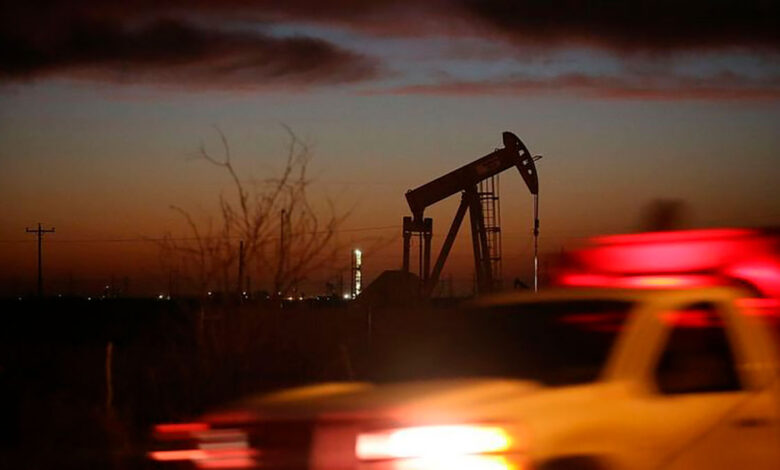What is the Permian Basin, the remote place in the United States that is experiencing a new boom with the explosion of oil prices

In a vast remote area between New Mexico and Texas, ravaged by frequent sandstorms, with reddish sunsets and the sweltering heat of the desert, is the largest natural energy reserve in the United States and one of the largest on the planet.
It was thanks to its exploitation that the United States managed to become in the world’s largest oil producer.
However, the Permian Basin, an area of 220,000 square kilometers in southwestern North America, was experiencing an unexpected twilight.
Last year, the coronavirus pandemic plunged energy market prices and extraction efforts fell sharply.
However, now, with a barrel of oil hovering around US $ 80 -and rising- the Basin is experiencing what the United States media have described as a new “boom”, to the point that several analysis firms believe that it will return to levels of pre-pandemic production in the coming weeks.
“A year and a half ago, everything was on the floor. Now the same traffic on the roads shows you that there is work again ”, tells BBC Mundo Fernando Acosta, a Cuban who works in the Permian Basin driving a tanker.
The new boom has been driven mainly by smaller private companies, while large firms such as Shell have sold their plots, a sign that experts see as indicative of the high prices at which such land can now be sold.
For many, it has been a new rebirth similar to what the region experienced more than a decade ago, when shale drilling began to make the US energy market self-sufficient.
The Permian Basin
The Permian Basin is so named because it is made up of one of the thickest rock deposits in the world from the Permian geological period (it began about 299 million years ago and ended about 251 million years ago).
Long ago, a vast prehistoric sea deposited rich organic material there over millions of years to form not only one of the densest hydrocarbon structures in the world, but also large reserves of potassium salts, rock salt, and other minerals.
But it was crude reserves that caused Texas to experience an economic boom throughout the 20th century.
The traditional wells, however, matured and by the end of the century, the Basin experienced another period of crisis.
According to Professor Jorge Piñón, an expert in energy issues at the University of Texas (USA), there were also energy reserves in other forms.
“Unconventional geological formations – as the category of geological formations called shales, shale, oil shales is called – is oil that is found within fissures within the rock and the only way to extract it is by fracturing the rock. You have to break the rock and extract that liquid ”, he explains to BBC Mundo.

According to the academic, these types of geological formations have been known for centuries, but there were two problems: the price of oil was not high enough to justify the profitability of exploiting these formations and there were not the appropriate technologies for their exploration.
However, the entry of the 2000s sent oil prices skyrocketing again and many large companies saw unconventional geological formations as a new way to produce oil and natural gas.
They then began to implement new techniques, such as fracking, with which the rock is fractured with pressurized water to extract the fuels.
The geological composition of the land itself also allowed the extraction of shale oil by drilling a single well.
The new formula that transformed the old traditional oil exploitation area, however, was not without controversy and environmental oragnizations for years. denounce the enormous pollution that occurs in the basin and the large amount of water needed for the fracking, even though the technique has improved.

In 2018, the U.S. Geological Survey estimated that the Delaware Basin in West Texas and Southern New Mexico had the potential to produce 46.3 billion barrels of oil and about 281 trillion cubic feet of natural gas. .
Currently, more than 70% of oil production in the United States comes from unconventional wells and almost 40% of that total comes from the Permian Basin (from which also more 15% of the natural gas produced in the country comes out), according to data from the Federal Reserve Bank of Dallas.
The success of the USA
According to Piñón, although other countries also have unconventional rock formations that would allow greater energy production, the United States – and the Permian Basin – have achieved great production due to a socio-political factor that goes beyond the same energy resources.
“Ultimately, what has allowed this development of production is that the United States is probably the only place in the world, with few exceptions, where mineral rights belong to the owners of the land and not to the State,” he says.

This, according to Piñón, has made things easier, slowed down bureaucracy and made production processes more effective.
However, the exploitation of the Basin has not been without controversy.
Being one of the world’s oil exploration fields, it has also been one of the most polluting ones.
According to reports from environmental agencies, methane levels that are expelled from there into the atmosphere have also returned to pre-pandemic levels, one of the highest in the world.
Data from the NGO Enviromental Defense Fund indicate that around 1.4 million metric tons of methane leak from the Basin each year, which would be enough gas to meet the annual gas needs of almost 2 million households.
This, according to the report, implies that its environmental damage triples the impact of burning the gas produced there in a period of 20 years.
And although the methods for recycling the water that is injected into the rock with the frackingEnvironmental groups have warned that this technique contaminates groundwater with chemicals, which can affect many communities in the western United States.
Several of the places where the wells are today are considered sacred territories by some American tribes, who have seen thousands of people arrive over the years near their reserves to work in the oil industry.
They are not the only ones.
The arrival of numerous workers to the area has also put many local communities in trouble, which have limited numbers of hospitals or infrastructures to accommodate a growing number of inhabitants.
All this has made the future of the Permian Basin a headache for both local and federal authorities.
And more during the current government, which advocates implementing greater environmental measures.
However, experts like Piñón believe that, beyond the regulations, it will be difficult to put an end to the production of the Basin, despite the changes in the near future that many already foresee for the energy sector.
“The decarbonisation of the energy sector does not stop. That train has already left. But that does not imply that oil is going to disappear, no matter how many Teslas or other electric cars are sold: 25% of the oil currently produced goes to the petrochemical industry, “he says.
“Already companies are returning to the Permian Basin and that is a sign that they see a future there at least in the next 10 to 30 years,” he says.
Now you can receive notifications from BBC Mundo. Download our app and activate them so you don’t miss our best content.
.


